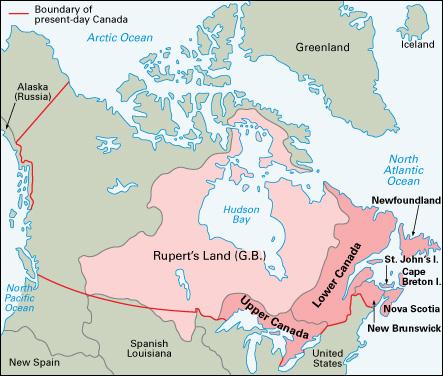Upper Canada was a British colony in North America. The British Parliament created Upper Canada in 1791. That year, the government divided its territory in what is now Ontario and Quebec into two colonies—Upper and Lower Canada. Upper Canada consisted of an area that is now southern Ontario. Lower Canada covered what is now southern Quebec.

The British created Upper Canada partly to accommodate United Empire Loyalists. The Loyalists were British subjects who had left the American Colonies after the American Revolution (1775-1783). They moved to different parts of the British Empire, including Canada. In 1791, Upper Canada had a population of about 10,000. Over the next two decades, a second wave of Loyalists, many of whom had been attracted by generous land grants, moved to the colony. After the War of 1812 between the United Kingdom and the United States, fewer Americans moved to Upper Canada. From 1815 to 1841, most new colonists in Upper Canada were from the United Kingdom, which then included Ireland.
Originally, agriculture was the main economic activity in Upper Canada. Settlers cleared the land and grew wheat, which became the colony’s chief export. To encourage commercial activity in Upper Canada, the colonial government invested heavily in _infrastructure—_that is, services and facilities that allowed the colony to function smoothly. The government leaders focused on the construction of canals in the 1820’s and 1830’s.
The British Parliament had granted Upper Canada representative institutions of government in 1791. The colonial legislature consisted of a British lieutenant governor, an appointed Legislative Council, and an elected Legislative Assembly. Political conservatives, called Tories or the Family Compact, dominated the legislature until the end of the 1820’s. As a result, Upper Canada developed an extremely British and conservative political and social character.
By 1828, the Family Compact faced challenges from members of the Legislative Assembly who wanted to reform the colony’s political and social institutions. The reformers wanted to end the Family Compact’s hold over government policy and government jobs and contracts. They wanted a more democratic system and policies that favored the needs of small farmers.
In December 1837, the most radical reformers launched an uprising against the colonial government. A similar uprising occurred in Lower Canada. The rebellion in Upper Canada failed, and the radical leaders who were not arrested fled to the United States. In 1838, they raided Upper Canada with little success.
In 1841, the British government united Upper and Lower Canada to form the Province of Canada. By that time, the population of Upper Canada had grown to more than 450,000.
